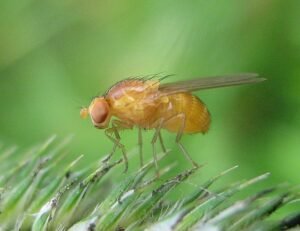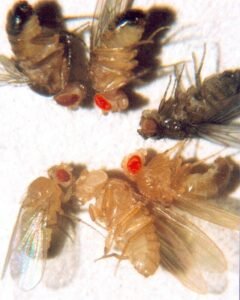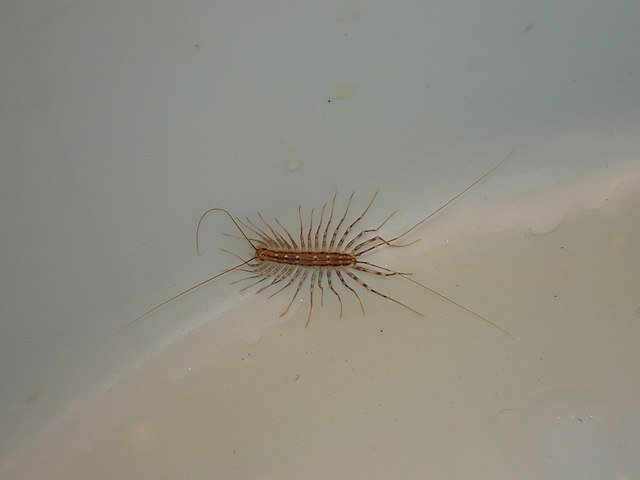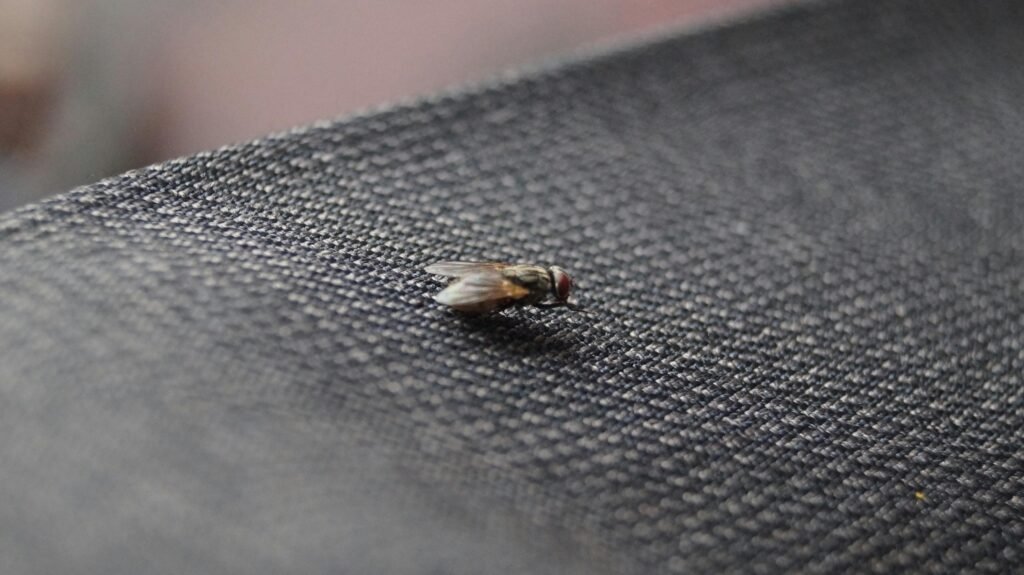Fruit Flies (Drosophila melanogaster): Identification, Risks & Control
 Fruit flies is a very importan parasite. Few pests are as universally frustrating as the Fruit Fly (Drosophila melanogaster). These tiny insects seem to appear from nowhere the moment a piece of fruit is left out on the counter. They hover in kitchens, bars, restaurants, supermarkets, and food storage facilities, quickly turning a fresh environment into a buzzing annoyance.
Fruit flies is a very importan parasite. Few pests are as universally frustrating as the Fruit Fly (Drosophila melanogaster). These tiny insects seem to appear from nowhere the moment a piece of fruit is left out on the counter. They hover in kitchens, bars, restaurants, supermarkets, and food storage facilities, quickly turning a fresh environment into a buzzing annoyance.
Unlike Drain Flies (Psychodidae) or Phorid Flies (Phoridae), fruit flies are directly tied to ripe and fermenting fruits, vegetables, and sugary liquids. Their presence is not only a nuisance but also an indicator of sanitation and food-handling issues.
This guide takes a deep dive into the biology, identification, risks, and management of fruit flies, helping both homeowners and professionals deal with one of the most persistent indoor pests.
Identification of Fruit Flies
Size: Adults are very small, typically 2–4 mm long.
Color: Tan to light brown bodies with bright red eyes (some species may have darker eyes).
Wings: Clear, slightly veined.
Behavior: Hover in swarms around fermenting food sources.
Larvae: Tiny, white, and worm-like, usually found inside decaying fruits and vegetables.
Fruit flies are often confused with Fungus Gnats (Sciaridae). Key differences: fruit flies hover near food sources, while fungus gnats stick close to soil and houseplants.
Biology and Lifecycle
Eggs: Laid on the surface of overripe or rotting fruits, vegetables, or other moist organic matter.
Larvae: Hatch within 24–30 hours and feed directly inside the fruit or substrate.
Pupae: Develop in or near the food source.
Adults: Emerge in about 7–10 days after egg laying.
A single female can lay up to 500 eggs in her lifetime, meaning populations can explode rapidly. Indoors, their life cycle continues uninterrupted if food sources are available.
Fruit flies thrive in temperatures between 24–30 °C (75–85 °F), which is why summer and early autumn are peak infestation periods.
Risks and Impact of the Flies of Fruits
 Food contamination: Fruit flies carry bacteria and yeasts from decaying matter to fresh produce.
Food contamination: Fruit flies carry bacteria and yeasts from decaying matter to fresh produce.Health risks: While not direct disease vectors like Mosquitoes (Culicidae), fruit flies can spread foodborne pathogens such as E. coli and Salmonella.
Commercial losses: In restaurants, bars, and supermarkets, infestations can result in reputational and financial damage.
Persistent infestations: Even after disposing of rotten produce, fruit flies may linger if breeding sites (e.g., trash bins, drains, recyclables) are overlooked.
Signs of Infestation
Small flies hovering around fruit bowls, trash cans, and liquor bottles.
Larvae visible inside overripe or rotting fruit.
Clusters of adult flies around sinks, drains, or recycling bins.
Household Control of Fruit Fly
Eliminate breeding sites: Discard overripe fruits and vegetables immediately.
Clean drains and bins: Organic residue in drains or trash is a common hidden breeding ground.
Proper food storage: Keep fruits and vegetables refrigerated or sealed.
Seal recyclables: Rinse bottles and cans before storing them for recycling.
Traps: Homemade vinegar traps or commercial fruit fly traps are effective for reducing populations.
Professional and Long-Term Control
For businesses, especially in food service:
Integrated Pest Management (IPM): A combination of sanitation, monitoring, and physical traps.
Drain treatments: Bio-enzymatic cleaners remove organic buildup that supports breeding.
Monitoring tools: Sticky traps help assess infestation levels.
Professional pest control services: In cases of chronic infestations, licensed professionals may apply targeted insecticides in non-food areas, though sanitation remains the cornerstone of control.
FAQs About Fruit Flies
Q: Where do fruit flies come from so quickly?
A: Fruit flies are highly sensitive to the smell of fermentation. They detect ripe or rotting fruit from long distances and lay eggs directly on the surface. Their rapid life cycle gives the impression that they “appear out of nowhere.”
Q: Are fruit flies dangerous to humans?
A: While they don’t bite, fruit flies spread bacteria and yeasts. They can contaminate food surfaces, posing a risk for foodborne illnesses.
Q: What is the difference between fruit flies and fungus gnats?
A: Fruit flies hover around fruit, drains, and alcohol. Fungus Gnats are linked to soil and houseplants. Their control methods differ.
Q: Can fruit flies breed in drains?
A: Yes. If organic sludge builds up, fruit flies may use it as a breeding site. Regular drain cleaning is critical for control.
Q: How long does it take to get rid of fruit flies?
A: With strict sanitation and trapping, infestations can be controlled in 5–7 days. Without eliminating breeding sources, they will persist indefinitely.
Final Thoughts
Fruit flies (Drosophila melanogaster) are among the most common household and commercial pests worldwide. Their presence is less about direct harm and more about what they signify—rotting food, poor sanitation, or overlooked waste.
Unlike Drain Flies, which thrive in wet organic matter, or Phorid Flies, which are linked to decay and sewage, fruit flies are tightly connected to fermentation and sugary residues. This makes them especially problematic in kitchens, restaurants, bars, and supermarkets.
The good news: infestations can be controlled effectively with diligence. Sanitation is the foundation. Remove their food sources, clean drains and trash bins, and store food properly. Traps and biological cleaners can support these efforts, but without addressing the root cause, infestations will return.
For homeowners, persistence in cleaning pays off. For businesses, professional pest management combined with staff training ensures compliance and customer confidence.
Fruit flies may be small, but their impact on food safety and perception is big. Staying proactive is the key to keeping them under control.
Disclaimer
This article is for informational purposes only. Pest control laws and approved chemicals vary by country. For best results and legal safety, we strongly recommend contacting a licensed pest control professional in your local area. Always make sure that the pest control technician is properly certified or licensed, depending on your country’s regulations. It’s important to confirm that they only use approved products and apply them exactly as instructed on the product label. In most places in Europe, UK, or USA, following label directions is not just best practice—it’s the law.
Author
Nasos Iliopoulos
MSc Agronomist & Certified Pest Control Expert
Scientific Director, Advance Services (Athens, Greece)
Licensed Pest Control Business – Ministry of Rural Development & Food (GR)
References
University of Kentucky Entomology – Fruit Flies
Wikipedia - Drosophila melanogaster

 Food contamination: Fruit flies carry bacteria and yeasts from decaying matter to fresh produce.
Food contamination: Fruit flies carry bacteria and yeasts from decaying matter to fresh produce.
